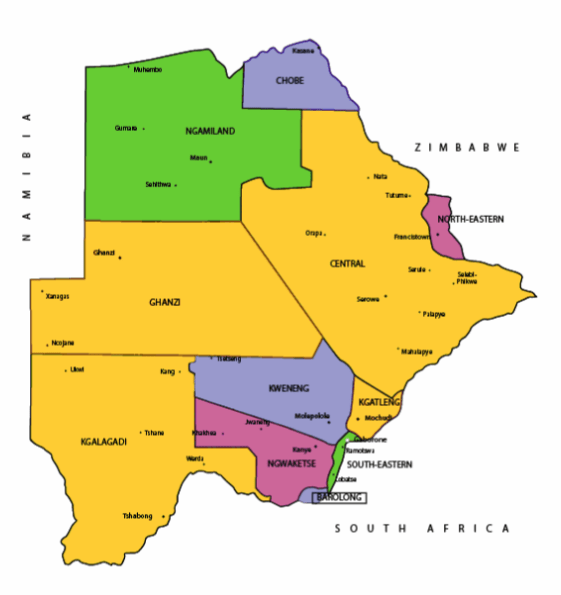Places and their polling stations in Kanye South, Botswana
418 Mmatshitswane
1962 Sebego Primary School
1963 Mookami JSS
1964 Logaba Kgotla
1965 Sebego Kgotla
1966 Logaba Primary School
1967 Kgano Kgotla
419 Lotlhakane East
1968 Lotlhakane Primary School
1969 Lotlhakane East Kgotla (Tent)
1970 Lotlhakane East Clinic (Tent)
1971 Phutisutlha Primary School
1972 Moreane Agriculture Storeroom (Tent)
1973 Maraka JSS
420 Kgwakgwe
1974 Masoke VDC House
1975 Ngwaketse JSS
1976 Mmamokhasi Kgotla (Tent)
1977 Ngwanamarungwana Mobile Health Stop
1978 Kgwakgwe (Tent)
421 Ruele
1979 Segopotso Primary School
1980 Motsatsing Primary School
1981 Lutheran Church
422 Nyorosi East
1982 Tsopye Kgotla
1983 Makaba Primary School
1984 Lehutshwana Kgotla (Tent)
423 Marapapalo
1985 Mongalo Kgotla (Tent)
1986 Marapalalo Community Hall
1987 Maisantwa Primary School
1988 Motheo English Medium Nursery And Pre-School
424 Nyorosi Central
1989 Kgwatlheng VDC Hall
1990 Khuto Primary School
1991 Maranyane Primary School
425 Nyorosi West
1992 Lopatlaoka Tent
1993 Khuto Ward (Tent)
1994 Ntebogang JSS
1995 Tloung Open Space (Tent)
426 Selokolela-Sesung
1996 Sesu Primary School
1997 Motlhatswe Kgotla
1998 Selokolela Primary School
1999 Selokolela Kgotla
2000 Sesu Kgotla
2001 Mmamaru Tent
427 Tsonyane
2002 Tsonyane Primary School
2003 Lobutse VDC Storeroom
2004 Tsonyane Kgotla
2005 Seherelela Primary School
2006 Betesankwe Primary School
2007 Lefhoko Primary School
2008 Seherelela Kgotla
Reference: iec.gov.bw/index.php/electoral-districts/polling-stations.html
Botswana
Botswana is a country in Africa. It is topographically flat, with approximately 70 percent of its territory being the Kalahari Desert.
It is bordered by South Africa to the south and southeast, Namibia to the west and north, and Zimbabwe to the northeast.
Capital: Gaborone
Currency: Botswanan Pula
Official language: English
Population: 2.588 million (2021) World Bank
Dialing code: +267
Gross Domestic Product: 17.61 billion USD (2021) World Bank
Botswana’s ten districts are:
- Southern District
- South-East District
- Kweneng District
- Kgatleng District
- Central District
- North-East District
- Ngamiland District
- Kgalagadi District
- Chobe District
- Ghanzi District
Botswana’s councils created from urban or town councils are: Gaborone City, Francistown, Lobatse Town, Selebi-Phikwe Town, Jwaneng Town, Orapa Town and Sowa Township.






The name Botswana refers to ‘Land of the Tswana’. The landlocked, Southern Africa country is officially known as the Republic of Botswana.














Botswana is connected to Zambia through the Kazungula Bridge making it the world’s shortest border between two countries.
A country of slightly over 2 million people (2021), Botswana is one of the most sparsely populated countries in the world. It is essentially the nation state of the Tswana ethnic group, who make up 79% of the population.

About 11.6 per cent of the population lives in the capital and largest city, Gaborone.
Formerly one of the world’s poorest countries—with a GDP per capita of about US$70 per year in the late 1960s—it has since transformed itself into an upper-middle-income country, with one of the world’s fastest-growing economies.


The Tswana ethnic group were descended mainly from Bantu-speaking tribes who migrated southward of Africa to modern Botswana, living in tribal enclaves as farmers and herders.




In 1885, the British colonised the area and declared a protectorate under the name of Bechuanaland.
As colonisation stopped, Bechuanaland became an independent republic under its current name on 30 September 1966.


Since then, it has been a representative republic, with a consistent record of uninterrupted democratic elections and the lowest perceived corruption ranking in Africa since at least 1998.

The economy is dominated by mining and tourism. Botswana has a GDP (purchasing power parity) per capita of about $18,113 as of 2021, one of the highest in subsaharan Africa.


Botswana is the world’s biggest diamond producing country.
Its relatively high gross national income per capita gives the country a high standard of living and the third-highest Human Development Index of continental Sub-Saharan Africa (after Gabon and South Africa).
The country has been adversely affected by the HIV/AIDS epidemic. In 2002, Botswana began offering anti-retroviral drugs (ARVs) to help combat the epidemic.
Botswana is a member of the Southern African Customs Union, the Southern African Development Community, the Commonwealth of Nations, and the United Nations.
